Corvette Action Center Deep Dive Series: Gasoline for your Corvette - Page 5 of 8
 |
 |
Page 5 of 8
© 2009 by Hib Halverson
No use without permission, All Rights Reserved
![]() Discuss this article
Discuss this article
Octane boosters-do they work?
While the majority of canned, liquid, "octane boosters" can raise octane, their practical benefits are sometimes overstated, misrepresented or non-existent. Common claims are that they increase octane by so many "points." These "points" are often not quantified, but the implication some manufacturers hope consumers will get is: one point equals one octane number. In some cases, these "points" are tenths of an octane number, ten times less than what some consumers believe.
Most boosters, if capable of a practical effect, work better with regular gas than with the higher octane, premium unleaded to which most people will add them because some of the components which raise octane are a very small proportion of regular grade gas but are present in larger quantities in premium fuel and, since the "if-some-is-good-then-more-is-better' rule doesn't apply to octane boosting components in gasoline; the effect of octane boosters on premiums is limited compared to their effect on regulars. Manufacturers making performance claims based on testing with regular gas, seldom admit it.
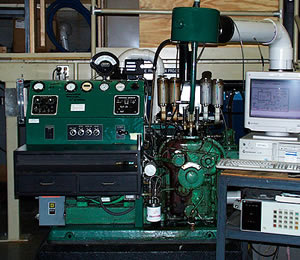
Laboratory, knock testing, such as that cited in our discussion of octane boosters, is done with sophisticated testing equipment. Here's the Waukesha CFR F1/F2, discussed earlier, in action. Image: Pennsylvania State University
One type of pour-in booster capable of useful octane increase uses "MMT" as its active ingredient. MMT stands for-try this tongue twister: methylcyclopentadienyl manganese tricarbonyl. Once considered a possible replacement for tetraethyl lead, while not as potent, it can raise octane. While it's been blended into gasoline in Canada since 1977, MMT is rejected by refiners in the U.S. in favor of other antidetonants, because 1) it's illegal in areas where RFG is required, 2) it can't be used in areas where it is legal due to contamination of pipelines, rail tank cars, tank trucks and storage tanks which also accommodate RFG and 3) some refiners feel its long-term use may compromise engine life. MMT is shunned by car companies, too, due to durability problems with emissions control systems and questions by the U.S. Environmental Protection Agency about it as a possible health hazard.
In spite of all this, in 1995, up to .031-gram-per-gallon of MMT was allowed in U.S. gasolines sold in areas not requiring RFG after its manufacturer, the Ethyl Corporation, won a Federal court case against the EPA. At this writing, no U.S. refiners add MMT to gasoline mainly because of the aforementioned distribution infrastructure contamination issue, but it is the key ingredient in a few canned octane boosters.
Several years ago, the CAC acquired test data from an independent research laboratory. Premium unleaded gas from a Chevron station in southern California tested at 96.3 RON and 88.3 MON for an (R+M)/2 rating of 92.3, 0.3-oct., higher than the rating on the pump. To a second sample of Chevron, the lab added the manufacturer's recommended proportion of a leading brand of non-MMT octane booster. The octane of the gasoline modified with this product was unchanged. The lab tested a third sample of Chevron 92 and NOS brand "Street Formula", an MMT octane booster, mixed 1:170 (12-oz. bottle in 16 gal. of gas). The results were: 96.8 RON, 88.4 MON and 92.6 R+M/2, a measurable change but, clearly, not a practical improvement. NOS' most potent booster, "Racing Formula", another MMT-based product, in Chevron super unleaded, tested at 98.5 RON, 90.4 MON and 94.5 R+M/2, a credible but modest improvement.
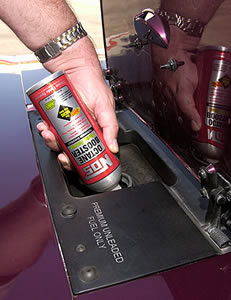
NOS Racing Formula should be mixed one bottle to about 16 gallons of gas. Lab testing and our dyno test showed this product to be a useful octane booster but, in most cases with 1975 or later street cars, because of potential damage to emissions controls devices, not a good value compared to mixes of racing gas and pump gas. Image: Author
That NOS Racing Formula lab-tested reasonably well, intrigued us enough to give it a practical test. We picked a 1995 ZR-1 equipped with an Auto Masters "Street Skinner" engine of about 500-hp. In hot weather, this 2nd-Gen. ZR-1's modified LT5 engine, when run on premium unleaded pump gas, detonated under high load and, thus, had spark retard as a result of knock sensing by the engine computer. We ran the car on a Super Flow SF-840 "AutoDyn" chassis dynamometer at Westech Performance Group in Mira Loma, California while monitoring the engine controls data with a Vetronix Mastertech scan tester. The engine intake air temperature (IAT) was 108 degrees F. Between peak torque and peak power, the Mastertech showed 5-8 degrees spark retard on each of several dyno tests.
The car had 15 gallons of Chevron, premium unleaded in it when we added a 12-oz. bottle of Racing Formula, drove it 5 miles to mix the booster thoroughly, then put the car back on the Auto-Dyn. This time, in spite of the IAT climbing to 115°F, the Mastertech showed a maximum of two degrees retard and, on three of six passes, read no spark retard at all. Run #5 was the best with power at the rear wheels up almost nine horsepower because the gasoline's octane was, now, just high enough to tolerate full spark advance.
Boosters with enough MMT to be effective are good for occasional use and limited increases in octane. Applications might be: 1) a stock, pre-'71, iron-head Corvette having a compression ratio between 9.5:1 and 10.5:1 or 2) an engine with a low-boost, streetable supercharger kit or a "mild" nitrous oxide injection system.
If you "read" spark plugs to tune your engine, the redish-brown MMT residue makes useful readings impossible and, also, shortens plug life. Do not use MMT boosters in concentrations higher than suggested by their makers because they will foul spark plugs, damage oxygen sensors (O2S) and plug catalytic converters. High percentages of MMT accelerate engine wear by contaminating engine oil and leaving hard metallic deposits in the combustion chambers, piston tops and upper end of the cylinder walls. That General Motors believes MMT causes problems with second generation, on-board diagnostics (OBD 2) has us concerned about long-term use of MMT-based octane boosters in '96 or later Vettes. MMT may be even more problematic with '04 or later cars having Tier 2 emissions controls.
In fact, we're not comfortable with long-term use of an MMT-booster in any engine with 02 sensors and cats. We base that on our 95 ZR-1 test vehicle having both catalytic converters fail shortly after the testing done for this article. We cannot state conclusively that use of the MMT-based octane booster was the sole cause of this, but having two converters fail simultaneously at 52,104 miles, significantly less than their projected service life, has us suspecting MMT had a role in the cats' premature demise.
One other pour-in product capable of useful increases antiknock rating is "Octane Booster" from Klotz Special Formula Products, Inc. There are reputable engine builders and tuners who feel Klotz's product works well when used as directed. During an interview, a source at Klotz refused to say what the product's active ingredient is, but denied it was MMT, toluene or alcohol. Based on reading Klotz's technical information, we know it's a proprietary mix of petroleum distillates and that it decreases the gasoline's burn speed and depresses its flash point. Klotz says that, when mixed 1:128 (one can to 16 gal. of gas), "Octane Booster" can move the octane of a 93-oct. pump gas to 95.5, or 2.5 octane numbers. We'll guess that's under ideal circumstances and your results may differ. Klotz "Octane Booster", while slightly less effective than NOS Racing Formula because it does not use MMT, doesn't have all the durability negatives an MMT-booster may bring to the table.
With all octane boosters, the more you add, the less effective they become. That is: a 1:64 mix will not double the octane boost you got from 1:128. Economics of the boosters discussed here can be better than mixes of pump gas and racing gasoline as long as the concentration is no more than about 1.5-oz per gallon of gas. Beyond that, mixes pump gas and racing gasoline are a better value. If you want to make pump gas into racing gas for engines with 10.5:1 or more compression, high-boost superchargers, big doses of nitrous or any engine run on a race track at sustained high-speed/high-load; forget it. No pour-in octane booster, in any quantity, will stop detonation under those conditions.
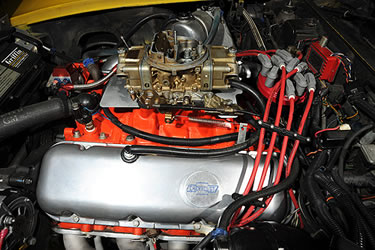 |
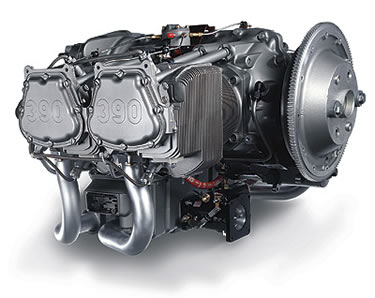 |
An MMT octane booster could be useful in an engine like this one: Big-Block with modest, 10.5:1 compression; roller cam; ported iron heads; big Holley 850 and needing a little octane boost over pump gas so it can use a full spark advance curve and high cylinder pressure without having problems with knock. Image: Author |
This is an IO-390, the newest aero engine from Lycoming engines, which is typical of a single-engine light airplane. It's a 390-cubic inch, four cylinder-12 cuin. more than the current base level Corvette engine, but only half as many cylinders. Its bore and stroke are 5.312" and 4.375" (a C6's LS3 is 4.065" by 3.622") and it makes peak power of 210-horsepower at 2700 rpm. The LL100 used in this engine is refined specifically for steady-state power output from a large displacement, low-rpm engine. Image: Lycoming Engines. |
Finally, if you run into an octane booster with "ferrocene" as its active ingredient, turn around and run the other way. Combustion of ferrocene results in iron oxide ("rust") which fouls spark plugs and, because it's abrasive, greatly accelerates engine wear.
How 'bout AvGas?
The only aviation gasoline of interest to Corvette enthusiasts is "low-lead 100" (AvGas LL100). Because of its availability, anti-knock rating and low price compared to leaded racing gasolines, AvGas might seem an obvious choice for a moderate octane boost, but closer study raises some doubt.
Because of its 2-gram-per-gallon lead content, AvGas must not be used by engines fitted with modern emissions controls. It renders catalytic converters useless in short order and will eventually plug them. AvGas quickly damages most oxygen sensors, too. Lastly, it reduces spark plug life. The sale and use of aviation gasoline is heavily-regulated. Most aircraft fuel dealers refuse to put AvGas into anything other than an aircraft fuel tank. There is a legal gray area that has some vendors willing to dispense AvGas into "approved" containers if they believe the end use of that AvGas is fueling an aircraft engine. This loop-hole is how some may obtain AvGas for automotive use.
Aviation gas is blended for large-bore, long-stroke, low rpm engines which run at high altitude. While AvGas' higher octane, required to be at least 99.5 MON, is useful; smaller-bore, shorter-stroke, high-rpm, non-cat Corvette engines, requiring more octane than is available with premium unleaded pump gas, will perform better on racing gasoline. AvGas has lower volatility so, used in proportions higher than about 40%, part-throttle drivability and cold starts may be compromised. AvGas has a lower specific gravity so it will require a change in air-fuel ratio calibration for the engine to perform at its best. LL100 is blended with a high percentage of aromatics. That reduces throttle response-not an issue with an aircraft engine, but certainly an issue in a high-performance automotive engine.
The biggest limitation of LL100, when used in very high-compression or high-boost, race-only applications requiring leaded gas, is low octane. "For those applications, AvGas," Rockett Brand's Tom Wusz told us, "is short on octane compared to most leaded racing gasolines. Many racing engines have more spark advance at low rpm and/or during lean, part-throttle operation than AvGas, and even some unleaded racing gasolines, can handle. The result is detonation."
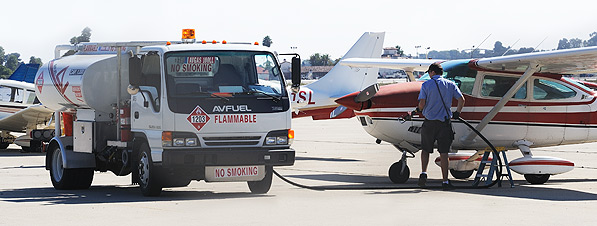 |
Most airports that cater to general aviation sell AvGas from fuel trucks such as this rig at the Santa Barbara Airport in California. If you decide to accept the compromises of aviation gasoline, make sure what you buy is "100" or "100LL". Do not use "Jet A". That's jet fuel, a form of kerosene, and burning it in an automotive engine will cause serious damage. Image: Author |
Bottom line: AvGas is ok in situations where a gasoline of no more than 100 MON is required, leaded fuel won't damage emissions controls devices, best performance is not important and you can accept possible drivability quirks. Otherwise, racing gasoline is a better choice.
 |
 |